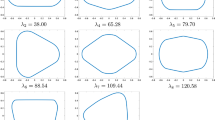Abstract
The notion of ε-kernel was introduced by Agarwal et al. (J. ACM 51:606–635, 2004) to set up a unified framework for computing various extent measures of a point set P approximately. Roughly speaking, a subset Q⊆P is an ε-kernel of P if for every slab W containing Q, the expanded slab (1+ε)W contains P. They illustrated the significance of ε-kernel by showing that it yields approximation algorithms for a wide range of geometric optimization problems.
We present a simpler and more practical algorithm for computing the ε-kernel of a set P of points in ℝd. We demonstrate the practicality of our algorithm by showing its empirical performance on various inputs. We then describe an incremental algorithm for fitting various shapes and use the ideas of our algorithm for computing ε-kernels to analyze the performance of this algorithm. We illustrate the versatility and practicality of this technique by implementing approximation algorithms for minimum enclosing cylinder, minimum-volume bounding box, and minimum-width annulus. Finally, we show that ε-kernels can be effectively used to expedite the algorithms for maintaining extents of moving points.
Similar content being viewed by others
References
Agarwal, P.K., Aronov, B., Har-Peled, S., Sharir, M.: Approximation and exact algorithms for minimum-width annuli and shells. Discrete Comput. Geom. 24, 687–705 (2000)
Agarwal, P.K., Aronov, B., Sharir, M.: Line transversals of balls and smallest enclosing cylinders in three dimensions. Discrete Comput. Geom. 21, 373–388 (1999)
Agarwal, P.K., Aronov, B., Sharir, M.: Exact and approximation algorithms for minimum-width cylindrical shells. Discrete Comput. Geom. 26, 307–320 (2001)
Agarwal, P.K., Guibas, L.J., Hershberger, J., Veach, E.: Maintaining the extent of a moving point set. Discrete Comput. Geom. 26, 353–374 (2001)
Agarwal, P.K., Har-Peled, S., Varadarajan, K.R.: Approximating extent measures of points. J. ACM 51, 606–635 (2004)
Agarwal, P.K., Har-Peled, S., Varadarajan, K.R.: Geometric approximation via coresets. In: Goodman, J.E., Pach, J., Welzl, E. (eds.) Combinatorial and Computational Geometry, pp. 1–30. Cambridge University Press, Cambridge (2005)
Agarwal, P.K., Procopiuc, C.M., Varadarajan, K.R.: Approximation algorithms for k-line center. Algorithmica 42, 221–230 (2005)
Arya, S., Malamatos, T., Mount, D.: Space-efficient approximate Voronoi diagrams. In: Proc. 34th Annu. ACM Symposium on Theory Comput., pp. 721–730 (2002)
Arya, S., Mount, D., Netanyahu, N., Silverman, R., Wu, A.Y.: An optimal algorithm for approximate nearest neighbor searching in fixed dimensions. J. ACM 45, 891–923 (1998)
Barequet, G., Har-Peled, S.: Efficiently approximating the minimum-volume bounding box of a point set in three dimensions. J. Algorithms 38, 91–109 (2001)
Basch, J., Guibas, L.J., Hershberger, J.: Data structures for mobile data. J. Algorithms 31, 1–28 (1999)
Bădoiu, M., Clarkson, K.: Smaller core-sets for balls. In: Proc. 14th Annu. ACM-SIAM Symposium on Discrete Algorithms, pp. 801–802 (2003)
Bădoiu, M., Har-Peled, S., Indyk, P.: Approximate clustering via core-sets. In: Proc. 34th Annu. ACM Symposium on Theory Comput., pp. 250–257 (2002)
Chan, T.M.: Approximating the diameter. Width, smallest enclosing cylinder and minimum-width annulus. Int. J. Comput. Geom. Appl. 12, 67–85 (2002)
Chan, T.M.: Faster core-set constructions and data stream algorithms in fixed dimensions. Comput. Geom. Theory Appl. 35, 20–35 (2006)
Clarkson, K.L.: Las Vegas algorithms for linear and integer programming when the dimension is small. J. ACM 42, 488–499 (1995)
Clarkson, K.L., Shor, P.: Applications of random sampling in computational geometry, II. Discrete Comput. Geom. 4, 387–421 (1989)
Gärtner, B.: A subexponential algorithm for abstract optimization problems. SIAM J. Comput. 24, 1018–1035 (1995)
Gärtner, B.: Smallest enclosing ball—fast and robust in C++. http://www.inf.ethz.ch/personal/gaertner/miniball.html
Gilmore, P., Gomory, R.: A linear programming approach to the cutting-stock problem. Oper. Res. 9, 849–859 (1961)
Har-Peled, S.: A replacement for Voronoi diagrams of near linear size. In: Proc. 42nd Annu. IEEE Sympos. Found. Comput. Sci., pp. 94–103 (2001)
Har-Peled, S.: A practical approach for computing the diameter of a point set (software). http://valis.cs.uiuc.edu/~sariel/research/papers/00/diameter/diam_prog.html
Har-Peled, S., Kushal, A.: Smaller coresets for k-median and k-means clustering In: Proc. 21st Annu. Sympos. Comput. Geom., pp. 126–134 (2005)
Har-Peled, S., Mazumdar, S.: Coresets for k-means and k-median clustering and their applications. In: Proc. 36th Annu. ACM Sympos. Theory Comput., pp. 291–300 (2004)
Har-Peled, S., Wang, Y.: Shape fitting with outliers. SIAM J. Comput. 33, 269–285 (2004)
Kumar, P., Mitchell, J., Yildirim, E.: Approximate minimum enclosing balls in high dimensions using core-sets. ACM J. Exp. Algorithmics (online) 8 (2003)
Kumar, P., Yildirim, E.: Minimum volume enclosing ellipsoids and core sets. J. Optim. Theory Appl. 126, 1–21 (2005)
Large geometric models archive: http://www.cc.gatech.edu/projects/large_models/
Mount, D., Arya, S.: ANN: library for approximate nearest neighbor searching. http://www.cs.umd.edu/~mount/ANN/
Todd, M.J., Yildirim, E.A.: On Khachiyan’s algorithm for the computation of minimum volume enclosing ellipsoids. Technical report 1438, Cornell University (2005)
Yao, A.C.: On constructing minimum spanning trees in k-dimensional spaces and related problems. SIAM J. Comput. 11, 721–736 (1982)
Zhou, Y., Suri, S.: Algorithms for a minimum volume enclosing simplex in three dimensions. SIAM J. Comput. 31, 1339–1357 (2002)
Author information
Authors and Affiliations
Corresponding author
Additional information
A preliminary version of the paper appeared in Proceedings of the 20th Annual ACM Symposium on Computational Geometry, 2004, pp. 263–272. Research by the first two authors is supported by NSF under grants CCR-00-86013, EIA-98-70724, EIA-01-31905, and CCR-02-04118, and by a grant from the US–Israel Binational Science Foundation. Research by the fourth author is supported by NSF CAREER award CCR-0237431.
Rights and permissions
About this article
Cite this article
Yu, H., Agarwal, P.K., Poreddy, R. et al. Practical Methods for Shape Fitting and Kinetic Data Structures using Coresets. Algorithmica 52, 378–402 (2008). https://doi.org/10.1007/s00453-007-9067-9
Received:
Accepted:
Published:
Issue Date:
DOI: https://doi.org/10.1007/s00453-007-9067-9




